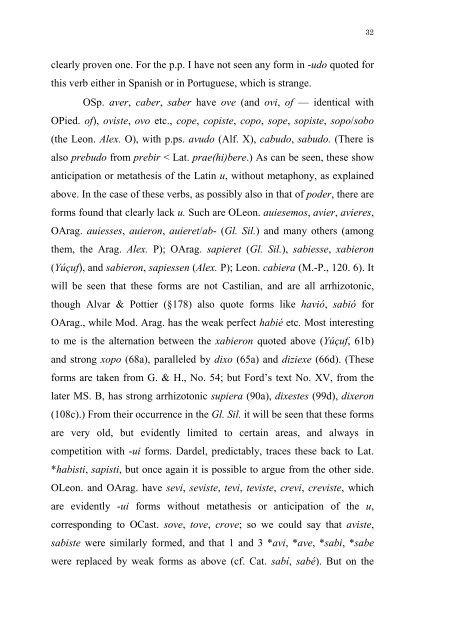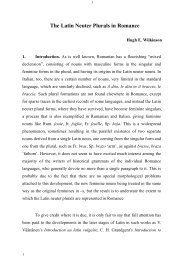THE STRONG PERFECTS IN THE ROMANCE ... - Page ON
THE STRONG PERFECTS IN THE ROMANCE ... - Page ON
THE STRONG PERFECTS IN THE ROMANCE ... - Page ON
You also want an ePaper? Increase the reach of your titles
YUMPU automatically turns print PDFs into web optimized ePapers that Google loves.
clearly proven one. For the p.p. I have not seen any form in -udo quoted for<br />
this verb either in Spanish or in Portuguese, which is strange.<br />
OSp. aver, caber, saber have ove (and ovi, of — identical with<br />
OPied. of), oviste, ovo etc., cope, copiste, copo, sope, sopiste, sopo/sobo<br />
(the Leon. Alex. O), with p.ps. avudo (Alf. Χ), cabudo, sabudo. (There is<br />
also prebudo from prebir < Lat. prae(hi)bere.) As can be seen, these show<br />
anticipation or metathesis of the Latin u, without metaphony, as explained<br />
above. In the case of these verbs, as possibly also in that of poder, there are<br />
forms found that clearly lack u. Such are OLeon. auiesemos, avier, avieres,<br />
OArag. auiesses, auieron, auieret/ab- (Gl. Sil.) and many others (among<br />
them, the Arag. Alex. P); OArag. sapieret (Gl. Sil.), sabiesse, xabieron<br />
(Yúçuf), and sabieron, sapiessen (Alex. P); Leon. cabiera (M.-P., 120. 6). It<br />
will be seen that these forms are not Castilian, and are all arrhizotonic,<br />
though Alvar & Pottier (§178) also quote forms like havió, sabió for<br />
OArag., while Mod. Arag. has the weak perfect habié etc. Most interesting<br />
to me is the alternation between the xabieron quoted above (Yúçuf, 61b)<br />
and strong xopo (68a), paralleled by dixo (65a) and diziexe (66d). (These<br />
forms are taken from G. & H., No. 54; but Ford’s text No. XV, from the<br />
later MS. B, has strong arrhizotonic supiera (90a), dixestes (99d), dixeron<br />
(108c).) From their occurrence in the Gl. Sil. it will be seen that these forms<br />
are very old, but evidently limited to certain areas, and always in<br />
competition with -ui forms. Dardel, predictably, traces these back to Lat.<br />
*habisti, sapisti, but once again it is possible to argue from the other side.<br />
OLeon. and OArag. have sevi, seviste, tevi, teviste, crevi, creviste, which<br />
are evidently -ui forms without metathesis or anticipation of the u,<br />
corresponding to OCast. sove, tove, crove; so we could say that aviste,<br />
sabiste were similarly formed, and that 1 and 3 *avi, *ave, *sabi, *sabe<br />
were replaced by weak forms as above (cf. Cat. sabí, sabé). But on the<br />
32









